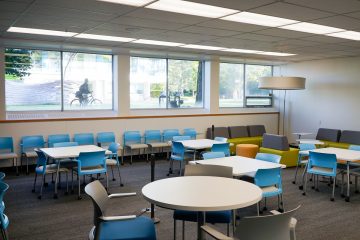Walking away from this afternoon’s session working with Secondary Jr. Science Methods TCs and their instructor Leslie Johnstone, I realized I hadn’t taken a single photo to help capture the engagement in the classroom. Ah, well, the moment will live in my brain at least ;D. Below are some promised links and notes about our session. 
We utilized one of the Scarfe Teaching and Learning Studios (Scarfe 1007) to provide a stations based approach allowing some student movement and choice (and to be sure students know that these ‘student priority’ spaces are available for them to use!). After a brief introduction in Prezi to five themes of technology integration, students had 10 minute opportunities to dip their toes into each theme at facilitated and self-directed stations.
Remember, in a Secondary Science classroom, especially if students are new to cooperative learning, I would advise creating groupings in advance of class. The groupings might be homogeneous or heterogeneous and based on any number of factors including ability or interest depending on the objectives of the teacher and the needs of the students. Sometimes, randomized groupings can be used and have the added benefit of introducing students to opportunities to interact with many different members of the class. There are many online options. GroupMind, a lovely little App developed by Louai Rahal an Education PHD student & instructor I met a few years ago, is free and open for you to use with no sign up required. For more on groupings, this article by Beatrice A. Ward (1987) is worth a read.
Our themes:
- Whole class student response – We discussed the value of incorporating approaches including digital technologies that move beyond ‘teacher asks question’, ‘students raise hands and respond one at a time’. Students had the opportunity to put their ‘teaching hats on’ and explore Padlet or Kahoot. Some might have seen this station as a wee bit off task as students became pretty engaged in playing ‘Halloween’ Kahoot… Still, with a little prompting, students were also considering issues including
- Student privacy (Kahoot and Padlet do not require students to login or give personal info!)
- What constitutes an effective question?
- How might gaming and competition impact student learning and how might it be leveraged or tempered…?
- Video and Simulations in the Science classroom – afford the opportunity for students to try experiments that might be otherwise impossible or, perhaps, just inaccurate if done hands-on. Sims and video can also support varied learners including ELLs in pre-playing or re-playing hands-on experiments. Check out PHET for some free, open access sims. For some amazing video experiments, see: Olympian vs. Toaster and Evolution of Bacteria on a Megaplate
- Google Tour Creator – Sharon Hu, Learning Design Strategist, shared the possibilities of creating a 360° VR environment that offers an immersive experience learners can explore on their own. Students found out how to use existing templates (ranging from human anatomy to the solar system) and how a group of learners can customize and annotate the template and use it as a collaborative storytelling tool.
- Teachers and students can create their own videos, digital stories and multimedia presentations using a variety of freely available tools including (but not limited to) Viva Video and Sway. *As UBC students, faculty and staff, we have access to some robust proprietary applications including:
- Camtasia (we’ll look at this one in another workshop!)
- VideoScribe (the animated hand we tried out today)<
- UBC Students, staff and faculty can download these and other applications either through ‘Canvas’ (click on Help
 and select ‘Software Distribution’) or through UBContheHub.
and select ‘Software Distribution’) or through UBContheHub.
- Augmented Reality – How might this emerging technology increase learning through rich media experiences and ‘hands’-on access to otherwise unaccessible objects or media? Does it go beyond toy?
- Theodore Gray’s Elements – interact with the periodic tables on a handheld device (this one is a paid app but very powerful and worth chatting with your school librarian about!)
- Science 360 – an app and website that houses a large database of science videos and content
- Leslie had fun sharing Curioscope Virtual-i-tee – a very cool AR T-shirt & accompanying App that allows students to peer inside the human body
- Merge Cube – this $15 AR spongy cube & accompanying free apps allow students to hold the the beating human heart, lungs, the earth and even the entire solar system in their hands! The ‘hologram’ that appears in your VR headset, ipad or smartphone is interactive to an extent (you can see different sides of an object by turning the cube or with a swipe or tap, adjust the view, see annotations, or even look inside of the object)
- StarWalk – allows you to see the night sky ‘in real time’ at any given place or time. Hold it up to view the horizon or sky above you; hold it down to the floor and see through to the southern hemisphere. This app is transformative in that without such an app, students really have a difficult time visualizing the movement of the celestial sphere (and we definitely can’t show them this during the school day!).
It was a pleasure working with the group of soon to become Educators! If you’d like to explore anything related to teaching, learning and digital technology further, please be in touch or click the ‘Ask a Question’ link in this blog. Look for Eric in the foyer on Wednesdays or visit Janis or Yvonne in a drop in or workshop sometime this winter! Schedule here.
Cheers!
Yvonne

